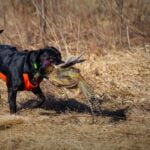Are you wondering how to train a dog to detect low blood pressure? Dogs are not only known for their loyalty and companionship, but they also have an incredible sense of smell that can be harnessed for medical detection purposes. In this article, we will explore the process of training a dog to detect low blood pressure, from understanding the condition and its symptoms to selecting the right dog for detection training and creating a training plan.
Using dogs for medical detection has become increasingly popular due to their exceptional olfactory abilities. They are capable of detecting various medical conditions, including low blood pressure, certain types of cancer, and even impending seizures. This unique capability has opened up new possibilities for utilizing dogs in the medical field, making them valuable assets in providing early detection and assistance in emergency situations.
In the following sections, we will delve into the specifics of training a dog to detect low blood pressure. We will discuss how to select the right dog for detection training, create a training plan, teach the dog to recognize low blood pressure, implement practice scenarios for real-life situations, monitor and evaluate the dog’s progress, and provide tips for maintaining the dog’s low blood pressure detection skills.
Additionally, we will share real-life success stories of dogs detecting low blood pressure and examine the impact of dogs in medical detection.
Understanding Low Blood Pressure and Its Symptoms
Low blood pressure, also known as hypotension, occurs when the force of blood against the artery walls is lower than normal. This can result in symptoms such as dizziness, fainting, blurred vision, nausea, fatigue, and difficulty concentrating. In severe cases, it can lead to shock or organ damage. Individuals who experience frequent episodes of low blood pressure may benefit from having a trained medical detection dog to alert them to potential drops in their blood pressure.
Dogs have an incredible sense of smell and are able to detect changes in a person’s body chemistry that occur during low blood pressure episodes. By understanding the symptoms of low blood pressure and how it affects the body, dog trainers can develop a specific training plan to teach dogs how to recognize these changes and respond appropriately.
When selecting a dog for low blood pressure detection training, it is important to choose a breed with a strong sense of smell and high intelligence. Breeds such as German Shepherds, Golden Retrievers, Labrador Retrievers, and Standard Poodles are commonly used for medical detection work due to their keen senses and trainability. It is essential to thoroughly evaluate the temperament and behavior of potential candidates before beginning training.
In order to successfully train a dog to detect low blood pressure, consistency and positive reinforcement are key. By creating a structured training plan that includes clear cues for identifying low blood pressure symptoms and rewards for successful alerts, trainers can effectively teach dogs to recognize these subtle changes in their handler’s body. Through careful planning and dedication, dogs can be trained to accurately detect low blood pressure episodes and provide valuable support for individuals with this condition.
Selecting the Right Dog for Detection Training
When it comes to training a dog to detect low blood pressure, selecting the right dog for detection training is crucial. Not all dogs are suited for this kind of work, so it’s important to carefully consider the breed, temperament, and training potential of a dog before beginning the process. Here are some factors to consider when selecting the right dog for low blood pressure detection training:
1. Breed: Certain breeds are known for their exceptional sense of smell and ability to be trained for medical detection. Breeds such as German Shepherds, Labrador Retrievers, and Bloodhounds are often preferred for this type of work due to their strong olfactory abilities.
2. Temperament: Dogs that are calm, focused, and eager to please are ideal candidates for low blood pressure detection training. It’s important to select a dog with a stable temperament and an affinity for human interaction.
3. Training Potential: Look for a dog that is responsive to training and shows a willingness to learn new tasks. Dogs with high intelligence and an eagerness to work are more likely to excel in medical detection training.
Once you have selected the right dog for low blood pressure detection training, it’s important to establish a strong bond with your canine companion before diving into the specific training techniques. Building trust and rapport with your dog will create a solid foundation for successful detection training down the line.
Training a dog to detect low blood pressure requires patience, consistency, and positive reinforcement. By selecting the right dog and laying the groundwork for a strong relationship, you can set the stage for effective training in this specialized field. With dedication and proper guidance, your canine partner can play a valuable role in monitoring low blood pressure and providing assistance in real-life situations.
Creating a Training Plan for Low Blood Pressure Detection
Understanding the Importance of Training
Training a dog to detect low blood pressure is not an easy task and requires a well-thought-out plan. It is important to recognize the impact that a well-trained detection dog can have on the lives of individuals with medical conditions such as low blood pressure. A properly trained detection dog can provide early warnings for potential health issues, allowing individuals to seek medical attention before a serious complication arises.
Setting Clear Objectives and Goals
When creating a training plan, it is crucial to establish clear objectives and goals. These could include teaching the dog to identify specific physical cues associated with low blood pressure, such as dizziness, fainting, or nausea. Additionally, the training plan should outline the desired level of accuracy and reliability in detecting low blood pressure episodes. Setting clear goals will help guide the training process and provide benchmarks for progress evaluation.
Utilizing Positive Reinforcement Techniques
Positive reinforcement techniques are essential when training a dog to detect low blood pressure. Rewarding the dog with treats, praise, or playtime when it correctly identifies symptoms of low blood pressure helps reinforce the desired behavior. Conversely, it is crucial to avoid punishment-based training methods, as these can lead to anxiety or fear in the dog. Consistent positive reinforcement will encourage the dog to confidently and reliably perform its detection duties.
During this stage there are numerous factors that need considering when establishing how to train your dog for this critical role for its owner’s health benefits time after time again.
Teaching the Dog to Recognize Low Blood Pressure
Training a dog to detect low blood pressure can be an incredibly valuable skill that can potentially save lives. Once you have selected the right dog for detection training and created a training plan, the next step is to teach the dog to recognize low blood pressure. Here are some tips on how to effectively train your dog to detect low blood pressure:
- Scent Recognition: Introduce your dog to the scent of low blood pressure by using samples from individuals with low blood pressure. You can use gauze pads or other materials that have been in contact with a person experiencing low blood pressure symptoms.
- Positive Reinforcement: Associate the scent of low blood pressure with positive reinforcement such as treats, praise, or playtime. When your dog correctly identifies the scent, reward them immediately to reinforce their learning.
- Consistent Training Sessions: Schedule regular training sessions with your dog to practice scent recognition. Consistency is key in reinforcing the association between the scent and positive reinforcement.
It is important to be patient and persistent when teaching your dog to recognize low blood pressure. Every dog learns at their own pace, so it may take time for them to fully understand and identify the scent. With consistent training and positive reinforcement, your dog can become proficient in detecting low blood pressure.
Once your dog has learned to recognize the scent of low blood pressure, it’s important to implement practice scenarios for real-life situations. This will help prepare your dog for actual detection situations and ensure that they can accurately identify low blood pressure when needed. By following these steps, you can effectively train your dog to detect low blood pressure and potentially make a significant impact in medical detection.
Implementing Practice Scenarios for Real-Life Situations
Simulating Low Blood Pressure Episodes
Once your dog has shown progress in recognizing low blood pressure, it is important to implement practice scenarios for real-life situations. This involves simulating low blood pressure episodes so that the dog can accurately detect and respond to them. You can work with a medical professional to create controlled scenarios where the individual intentionally experiences a drop in blood pressure, allowing the dog to practice their detection skills in a controlled environment.
Reinforcing Training in Different Environments
It is crucial to expose the dog to various environments and situations where they might need to detect low blood pressure. This includes practicing in different rooms of the house, outdoors, or even in public places such as parks or shopping centers. By exposing the dog to different environments, you are ensuring that their detection skills are not limited to a specific setting, but rather can be applied wherever their assistance may be needed.
Using Positive Reinforcement and Rewards
During practice scenarios, it is essential to continue using positive reinforcement and rewards to encourage the dog’s behavior. Each time the dog correctly identifies an episode of low blood pressure, be sure to praise them and offer a treat or favorite toy as a reward. This positive reinforcement will strengthen their detection skills and motivate them to continue performing well.
By implementing practice scenarios for real-life situations, you are fine-tuning your dog’s ability to detect low blood pressure and ensuring that they can effectively respond when their assistance is needed. Consistent training and exposure to various environments will further enhance your dog’s capabilities in medical detection.
Monitoring and Evaluating the Dog’s Progress
Dogs have been proven to be capable of detecting a wide range of medical conditions, including low blood pressure. This section will focus on monitoring and evaluating the progress of a dog being trained to detect low blood pressure. Once you have selected the right dog and created a training plan, it is important to continuously assess the dog’s development in this specialized skill.
Monitoring the dog’s progress involves tracking their ability to accurately detect low blood pressure in various scenarios. This can be achieved through regular training sessions and mock situations where the dog is presented with individuals experiencing low blood pressure. It is essential to keep detailed records of the dog’s performance during these sessions, noting any improvements or areas that still need work.
Evaluating the dog’s progress is crucial in understanding their capability to effectively detect low blood pressure. This may involve seeking the expertise of a professional trainer or veterinarian who can provide an objective assessment of the dog’s performance. Additionally, utilizing technology such as heart rate monitors and blood pressure cuffs during training sessions can help measure the accuracy of the dog’s detection abilities.
Real-life scenarios should also be incorporated into the evaluation process, allowing the dog to apply their training in practical situations. This could involve placing them in environments where individuals with low blood pressure are present and observing their response. By closely monitoring and evaluating the dog’s progress, adjustments can be made to their training plan as needed, ultimately enhancing their ability to detect low blood pressure reliably.
| Monitoring and Evaluating | Dog’s Progress |
|---|---|
| Regular training sessions | Track ability to detect low blood pressure |
| Seek professional evaluation | Utilize technology for measurement |
| Incorporate real-life scenarios | Adjust training plan as needed |
Tips for Maintaining the Dog’s Low Blood Pressure Detection Skills
After putting in the time and effort to train your dog to detect low blood pressure, it’s important to continue practicing and maintaining their skills. Consistent training and reinforcement are key to ensuring that your dog remains proficient in this important task.
One way to maintain your dog’s low blood pressure detection skills is to incorporate regular training sessions into their routine. By consistently working on detection exercises, you can keep their abilities sharp and reinforce their training. This could include using scent samples or enlisting the help of a friend or family member to simulate real-life scenarios for practice.
It’s also crucial to provide ongoing positive reinforcement and rewards for successful detection efforts. This could be in the form of treats, praise, or playtime. By continuing to positively reinforce their detection skills, you can ensure that they remain motivated and focused during training sessions.
In addition, regularly monitoring and evaluating your dog’s performance is essential for maintaining their low blood pressure detection skills. Keep track of their accuracy and alertness during training exercises, making note of any areas where they may need additional support or practice. With consistent training, positive reinforcement, and ongoing evaluation, your dog can continue to excel in detecting low blood pressure effectively.
| Maintaining Your Dog’s Skills | How It Helps |
|---|---|
| Incorporate regular training sessions | Keeps abilities sharp and reinforces training |
| Provide ongoing positive reinforcement | Ensures motivation and focus during training sessions |
| Monitor and evaluate performance | Identifies areas needing additional support or practice |
Real-Life Success Stories of Dogs Detecting Low Blood Pressure
There have been numerous success stories of dogs detecting low blood pressure in their owners, saving lives and providing much-needed support for individuals suffering from this condition. One such story is that of a Labrador named Max, who was trained to detect changes in his owner’s blood pressure. Max has successfully alerted his owner multiple times when her blood pressure dropped to dangerous levels, allowing her to seek medical attention before it became life-threatening.
In another heartwarming example, a rescue dog named Luna was trained to detect low blood pressure in her owner who suffers from a chronic illness. Luna’s ability to sense changes in her owner’s blood pressure has not only brought peace of mind to the family but has also proved invaluable in managing the condition effectively.
These real-life success stories highlight the incredible potential of using dogs for medical detection, particularly in monitoring low blood pressure. The bond between these specially trained dogs and their owners goes beyond companionship – it becomes a lifeline for those struggling with health challenges.
These inspiring stories serve as a testament to how remarkable and life-saving the training of dogs for low blood pressure detection can be. With proper training, dedication, and teamwork, these dogs have proven themselves to be invaluable allies in managing and improving the quality of life for individuals with low blood pressure.
Conclusion
In conclusion, training a dog to detect low blood pressure can have a significant impact on the lives of those affected by this condition. By utilizing the natural abilities and keen sense of smell that dogs possess, they can be invaluable in detecting low blood pressure and alerting their owners or caregivers. With dedication, patience, and a thorough training plan, dogs can be trained to recognize the symptoms of low blood pressure and provide crucial assistance to those in need.
The process of selecting the right dog for detection training is crucial, as different breeds have varying levels of sensitivity to scent and different temperaments. Creating a comprehensive training plan that includes teaching the dog to recognize low blood pressure symptoms and implementing practice scenarios for real-life situations is essential for success. Monitoring and evaluating the dog’s progress throughout the training process is also important in ensuring that they are accurately detecting low blood pressure.
As shown in numerous real-life success stories, dogs have proven to be remarkably effective in detecting low blood pressure and providing early intervention. With proper maintenance of their detection skills through continued practice and reinforcement, these dogs can continue to make a profound impact on the lives of those with low blood pressure. Through dedication, patience, and perseverance, it is possible to train a dog to detect low blood pressure effectively and change lives for the better.
Frequently Asked Questions
Can a Dog Detect Low Blood Pressure?
Yes, it is believed that dogs can detect low blood pressure. There have been anecdotal reports of dogs alerting their owners to drops in blood pressure before any symptoms occur.
Can You Train a Dog to Sense Blood Pressure?
Yes, it is possible to train a dog to sense changes in blood pressure. With proper training and positive reinforcement, dogs can learn to recognize the physiological signs of low blood pressure and alert their owners.
How Do Service Dogs Alert for Low Blood Pressure?
Service dogs can be trained to alert for low blood pressure through various methods such as pawing, nudging, or even fetching a medical kit. They are able to recognize the scent of chemical changes in their owner’s body and respond accordingly.

Welcome to the blog! I am a professional dog trainer and have been working with dogs for many years. In this blog, I will be discussing various topics related to dog training, including tips, tricks, and advice. I hope you find this information helpful and informative. Thanks for reading!





